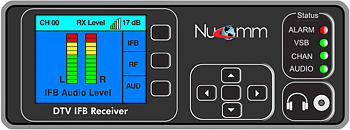ENG and the Lines of Communication
SEATTLE Remotely controlling an ENG van's equipment from the studio is a story of technology. But to be successful these days, new technology needs to offer advantages not only for engineers but to the folks in the finance office as well. Judging by what vendors are saying, what's coming in ENG remote control will satisfy both sides.
From the standpoint of the finance guys, remotely controlling an ENG van's equipment can reduce headcount. Operating sophisticated microwave gear in the field not only takes a body, but a technically skilled body, someone above the intern or minimum wage level. If you can give remote control of one or several ENG vans to a single operator back at the station, bean-counters can see that they'll save beans.
HUNT & SEEK
But where does this help the operators? Actually, such remote control can help both at the station and in the field. For one thing, it can eliminate what N Systems President Stephen Neuberth describes as the old "hunt-and-seek" method of aiming the transmit antenna.
"The operator at the studio has a lot of things to do," Neuberth said. He picks up valuable time "if he doesn't have to sit there on the two-way and talk to an operator in the field who's panning the antenna, saying 'Wait! You just passed it, back up.'"

Nucomm's ProQ DTV IFB Receiver uses a station's ATSC signal as a return channel from the studio to the news van. In contrast, if the operator at the studio has control of both the antenna at the transmit site and its companion at the receive site, he can adjust both while watching the signal optimize on the monitoring equipment at his console. Coordinating antenna polarization, turning transmitter power on and off, and adjusting transmitter power level are all remote control functions.
In fact, because the operator at the station can remotely control equipment in a fleet of vans, he's in a better position than a field operator to fire up and power down a succession of ENG transmitters during a fast-paced news program.
What's in it for the guy out in the field? He can raise the mast (still a manual task due to safety considerations), then head off to cover the news.
So if remote controlled ENG makes so much sense, why hasn't it been done for years?
Electronic newsgathering was developed on a "simplex," or one-way model. While there had to be some sort of two-way walkie-talkie communication between the studio and the van, the uninterrupted connection was always from the field back to the studio, so the story could go live on the news.
"The first step we need to do is to build an IP infrastructure," said Ben McLeod, vice president of marketing at Microwave Radio Communications. "That means a two-way, bidirectional communications link between the central resources at the station and the remote asset in the ENG vehicles."
Stations have spent a lot of money building high-bandwidth ENG infrastructures to bring standard-definition and now high-definition video from the field back to the studio. Fortunately, remote control doesn't demand such high bandwidth, and there are a plethora of connectivity options coming online to deliver those instructions out to the van, such as 3G cellular phone networks, WiMAX, Wi-Fi, and even the broadcaster's own 8-VSB transmitted signal. There's also the DRL (data return link) spectrum. In addition to having a data path from the studio to the ENG van, the equipment itself also has to be remotely controllable. But much of the new generation of microwave gear has just that. "We have the capability to talk to the transmitter and control it," said Sam Nasiri, president of Global Microwave Systems. "We have RS-232 as a way of talking to our transmitters and receivers, as well as USB." GMS' example is typical of the industry.
PURPOSE BUILT
Remote control also requires some purpose-built remote-control enabling equipment. Nucomm recently introduced its ProQ DTV IFB Receiver, which "uses the station's ATSC signal as a return channel from the studio back to the news van," said John Payne IV, Nucomm vice president of engineering.
In addition to carrying multiple channels of IFB audio out to talent in the field, the ProQ system can carry remote control signals. "We have some RS232 connections that can pass through the product, as well as a tally indicator system for the cameras," said Payne. "We've actually used it to control an ENG transmitter, turning it on, turning it off, changing channels."
Just how much of an 8-VSB channel's bandwidth does the ProQ operation occupy? Payne noted that maintaining low latency has a big effect on the necessary bandwidth, but that ProQ can send eight channels of audio and the remote control data at 100 kbps, or about .5 percent of a 19.39 Mbps ATSC stream.
Troll Systems introduced its vanLink system at the 2008 NAB Show. "Now the truck is just another remote site, and we treat it the same way as a receive site," said Troll CEO Julian Scott. "It ties the two together and now it's able to do automatic alignment of both antennas, change channels accordingly, coordinate antenna polarization."
With the vans in the field reporting their GPS positions telemetrically to vanLink, the ENG vans show up on an area map displayed by the system.
Referring to NSI's MC5 PC-based remote control system and its audio link function, Neuberth said, "with the push of a single button, they can get the entire shot lined up, both the transmit side and the receive side. The operator has plenty to do already."
The professional video industry's #1 source for news, trends and product and tech information. Sign up below.
